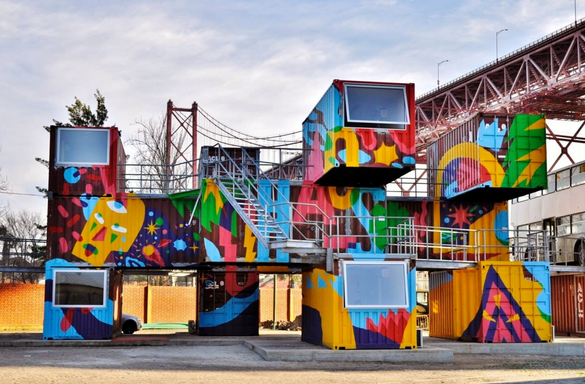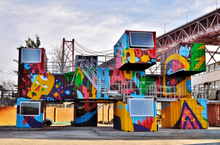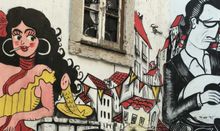 31 Oct 2024
31 Oct 2024
Few would dispute Lisbon's reputation as one of the world's most vibrant cities, as recently affirmed by its recent success as Europe's Leading City Destination at the 2024 World Travel Awards, but this vibrancy takes on many forms and arguably none as colourful as its eclectic art scene. Here Visit Lisboa shares some tips on how to best experience the city through its art, from street art parks and azulejos to museums, galleries and tuk tuk tours.
Located along the banks of the Tagus River, the Marvila Art District is a dynamic neighbourhood that has been transformed from an industrial area into a thriving cultural hub, making it an ideal location for art enthusiasts. The Marvila Art District's purpose is to challenge the stereotypes of museums, cultural centres and traditional galleries, by focussing on contemporary art created by young artists and especially to promote artists and art via an exhibition, work and social space for local and international artists. Here visitors can discover all there is to know about Lisbon's art scene, visiting galleries and exhibitions on an unforgettable journey through the district.
Covering an area if 1,500 square metres, Lisbon's Street Art Park in the Lumiar district of the city is a freely accessible space open to the public with 14 large walls on which people can express their inner artist and paint freely at any time of the week without any restrictions. The park opened in June 2022 and is the result of an agreement between the Lisbon City Council and the SuperBock Group and is the first of its kind to offer this kind of opportunity for would-be artists. The creation of this space, dedicated to street culture, represents an effort on behalf of the City Hall to implement a new policy towards the issue of illegal graffiti and vandalism on public property by embracing it proactively rather than trying to stop it or eradicate it.
Fado Vadio is a mural tribute to fado and can be found in the neighbourhood of Mouraria at the escadinhas de São Cristóvão. This inspired and original tribute to fado portrays the symbols and figures from the history of fado over various walls. The neighbourhood of Alfama also has streets adorned with Fado-themed tiles and murals, often depicting scenes from famous Fado songs or portraits of iconic singers.
Another of Lisbon's art forms can be seen through the azulejos, Portuguese tile-making, rich in history and visible in various guises from antique panels to more modern work. Every neighbourhood of Lisbon is replete with it, where the eras, styles and resistance to the passing of time are clearly visible. Although you can't see them all, since many are hidden in private houses, the city has many stunning facades, some of which have survived many catastrophes. Enthusiasts can discover all about their history at the Museu do Azulejo and wander the streets of Alfama, Mouraria and Chiado in search of incredible examples.
One of the best ways to explore Lisbon's street art and azulejos is in on one of the many tuk tuks that can be seen around the city. Tuk Tuk rides are a new way of experiencing, seeing, feeling and living the city in an eco-friendly and personalised way and the tours enable visitors to check out the various street art districts and venues, whilst also discovering narrow streets, alleys, small squared and stunning viewpoints.
Visitors to Lisbon are spoilt for choice when it comes to museums and galleries displaying a multitude of various art forms to suit each and every taste. The Centro Cultural de Bélem houses one of the best modern art collections in the Museu Coleção Berardo, whereas the National Museum of Contemporary Art – Museu do Chiado – is a must-see for those wanting to learn more about Portugal's art scene from 1850 until the present day.
For those with more historic art tastes, the National Ancient Art Museum houses a collection of amazing artworks from the 12th to 19th centuries, including paintings, sculptures, silver, gold and jewellery and decorative arts – from Portugal, Europe, Africa and the Orient. Alternatively, the São Roque Museum is one of the most beautiful and complete museums of Portuguese religious art and the Gulbenkian Museum houses the largest collection of 20th Century Portuguese art, with its temporary exhibitions attracting thousands of visitors every day.
For more information, ideas, and inspiration on visiting Lisbon, go to www.visitlisboa.com.
-Ends-
Notes to editors
About Turismo de Lisboa
Turismo de Lisboa is a non-profit organisation established through an alliance of public and private bodies operating in the tourist sector. It has around 900 associated members. Since its inception in 1998, the main objective of this association is to improve and increase the promotion of Lisboa as a tourist destination and therefore enhance the quality and competitiveness of the city.
For media information and images, please contact Hume Whitehead Ltd:
Richard Hume (richard@humewhitehead.co.uk / 020 3375 4050)
Laura Boo (laura@humewhitehead.co.uk / 020 3375 4056)




